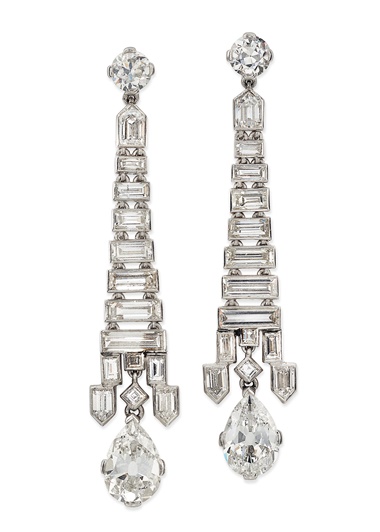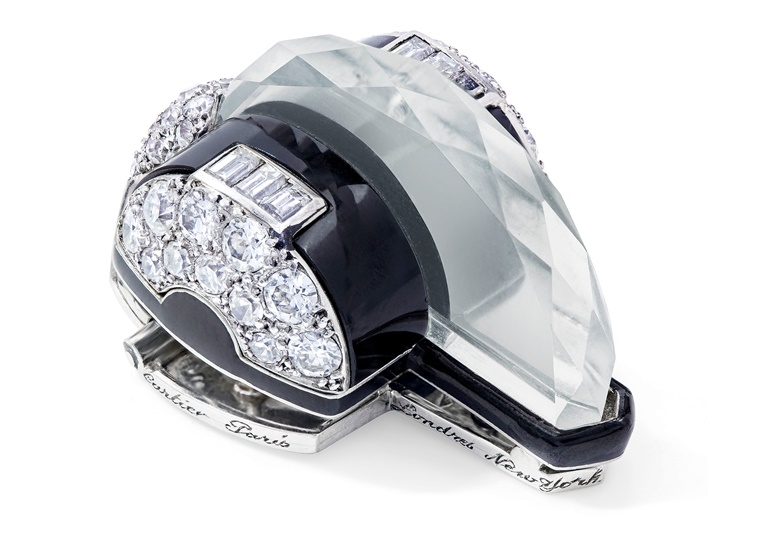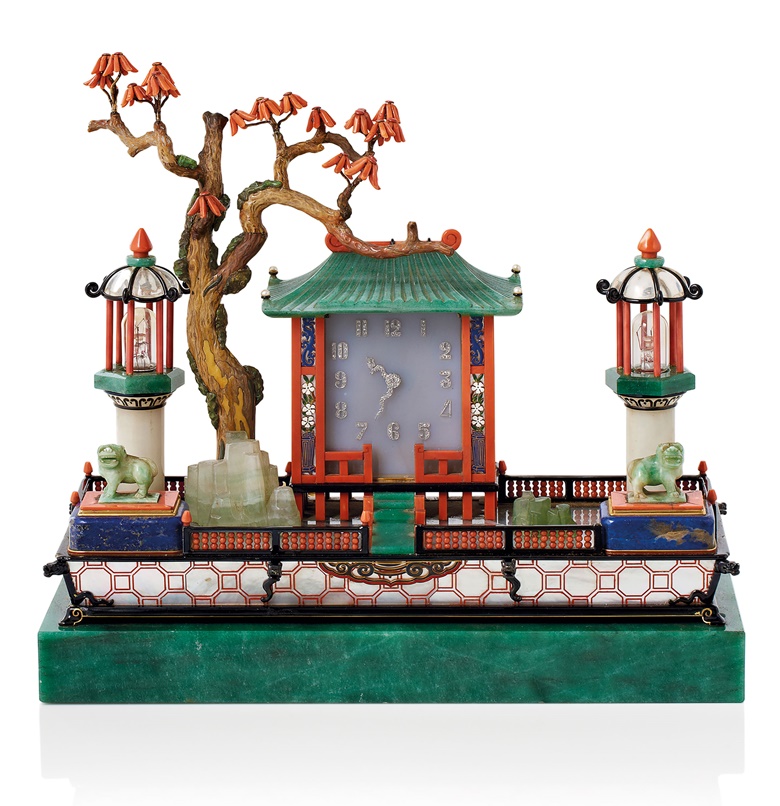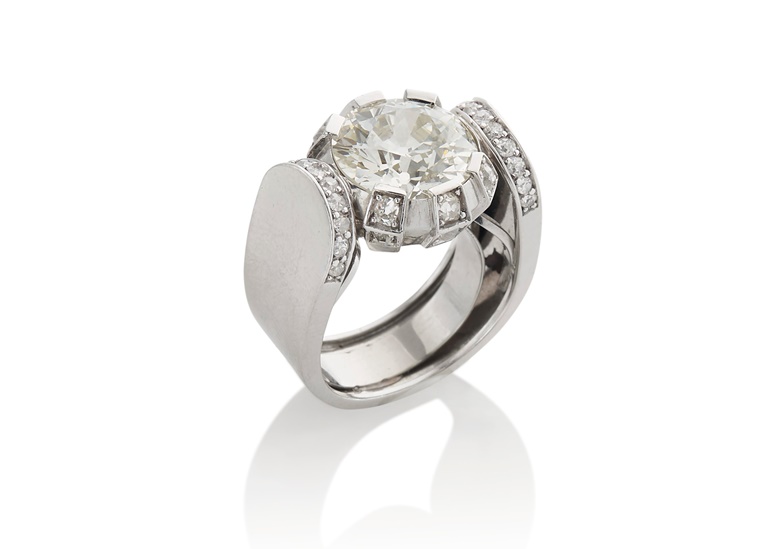Entrez dans le royaume de l'avant-garde, où les échos de la Grande Guerre s'estompent pour laisser place aux lignes nettes d'une nouvelle ère. Alors que l'Europe émergeait des cendres du conflit, l'expression artistique a connu un changement sismique. Les courbes organiques de l'Art nouveau disparaissent au profit de la précision géométrique de l'Art déco.
This revolution in design, born from the crucible of post-war reconstruction, found its zenith in the Exposition Internationale des Arts Décoratifs et Industriels Modernes of 1925. Here, amid the gleaming halls of Paris, the world bore witness to the birth of a new aesthetic. Art Deco, with its bold embrace of modernity and celebration of technological progress, emerged as the defining style of the era.
At the heart of this movement were the visionary jewellers who dared to defy tradition and embrace innovation. Casting aside the ornate embellishments of yesteryear, they crafted jewels that exuded a sense of streamlined elegance and architectural allure. From sleek geometric motifs to bold color contrasts, each piece was a testament to the spirit of the age.
Join us as we explore the world of Art Deco jewellery through the lens of Christie’s, where exquisite pieces from this iconic era come to life. From dazzling diamond bracelets to striking onyx necklaces, these treasures encapsulate the essence of a bygone era, where innovation and sophistication reigned supreme.
.jpg?mode=max&width=1025?w=380)
Baily Banks & Biddle & Co. presents an Art Deco masterpiece: a diamond and synthetic ruby pocket watch. Estimated at CHF 10,000-15,000, this exquisite timepiece is featured in Jewels Online: The Geneva edit, taking place from 8-20 July 2021, available exclusively online.
.jpg?mode=max&width=1025?w=380)
Presenting a timeless marvel from Cartier: an Art Deco diamond and enamel pocket watch. Anticipated to fetch CHF 12,000-18,000, this exquisite piece is showcased in Jewels Online: The Geneva edit, running from 8-20 July 2021, exclusively online.
Until 1935, and with lasting influence into the 1940s, renowned jewelers including Cartier, Van Cleef & Arpels, Maison Janesich, Ostertag, René Boivin, Paul Brandt, Raymond Templier, and Fouquet collaborated with artists and architects to refine the interplay between form and function. Evolving from sweeping, organic lines and nature-inspired motifs, design shifted towards geometric simplicity, embracing clean lines, contrasts, and vibrant colors.

A stunning exemplar of Art Deco elegance, behold the Art Deco sapphire ring crafted by the renowned Raymond Templier. This masterpiece, sold for CHF 125,000 on 13 November 2017 at Christie’s in Geneva, stands as a testament to Templier’s mastery of design and craftsmanship.

Exemplifying the epitome of Art Deco sophistication, these diamond earrings feature circular, pear, and baguette-cut diamonds, exquisitely arranged to captivate the eye. Sold for £46,250 on 27 November 2019 at Christie’s in London, these earrings not only showcase impeccable craftsmanship but also epitomize the glamour and allure of the Art Deco era.
New materials and combinations
According to decorative arts historian Melissa Gabardi, the Art Deco movement “rejected the dictates of the past.” Art Deco jewelry embraced sleekness and boldness, marked by sharp edges and uniformity in surface, line, and volume. Designs featured unconventional combinations of stones, mixing natural materials like onyx, emeralds, rubies, jade, silver, ivory, lapis, and rock crystal with synthetic ones such as plastic and glass.
.jpg?mode=max&width=1025?w=780)
Presenting an exquisite fusion of elegance and Art Deco opulence, this Cartier jabot pin features nephrite, coral, enamel, and diamonds, embodying the essence of luxury and refinement. With an estimated value of CHF 15,000-20,000, it stands as a testament to Cartier’s mastery of design and craftsmanship. Offered in Jewels Online: The Geneva edit, 8-20 July 2021, this piece epitomizes the timeless allure of Art Deco aesthetics.
“Designers from varied backgrounds shared a common vision: to break away from tradition, find inspiration in the ordinary, and strip decorative arts of unnecessary embellishments,” explains Laurence Mouillefarine, a historian specializing in the Art Deco era.
Just as women’s clothing adopted streamlined silhouettes, jewelry followed suit, embracing cleaner lines and simpler designs.
Art Deco shapes didn’t necessarily become simpler; instead, they evolved to be more linear and streamlined, eschewing large gemstones in favor of small, brilliant-cut diamonds.
.jpg?mode=max&width=1025?w=780)
Exemplifying the sophistication of the Art Deco era, this diamond brooch is a stunning representation of timeless elegance. With an estimated value of CHF 1,000-1,500, it offers a touch of luxury and refinement to any ensemble. Offered in Jewels Online: The Geneva edit, 8-20 July 2021, this exquisite piece is a testament to the enduring allure of Art Deco design.
This liberated sensibility mirrored shifts in women’s fashion, epitomized by the androgynous silhouettes pioneered by figures like Paul Poiret and Coco Chanel, which granted women greater freedom of movement.
.jpg?w=780)
This Janesich Art Deco fibula brooch, crafted in the 1930s, epitomizes the elegance and sophistication of its era. Adorned with coral, diamond, and enamel, it sold for CHF 75,000 at Christie’s in Geneva on 13 November 2017. A true masterpiece of Art Deco craftsmanship, this brooch is a testament to the enduring allure of vintage luxury.
During the later Art Deco period, as women’s fashion embraced more structural elements, clips and double-clip brooches gained popularity.
.jpg?mode=max&width=1025?w=780)
This Art Deco brooch, featuring a dazzling array of diamonds, sapphires, emeralds, and rubies, is a testament to the opulence of its time. With an estimate of CHF 2,000-3,000, it exemplifies the exquisite craftsmanship and elegant design characteristic of the Art Deco period. Don’t miss the chance to acquire this stunning piece of vintage luxury at the Jewels Online auction: The Geneva edit, running from 8-20 July 2021.
Contrast, colour, and crystal
Art Deco jewellery designers emphasized geometric shapes in their designs, accentuating contrasts in color as well.

This Cartier Art Deco clip brooch is a masterful fusion of luxurious materials and geometric design, characteristic of the 1920s aesthetic. Featuring a central rock crystal panel, onyx accents, and a dazzling array of old and baguette-cut diamonds, all set against a backdrop of sleek black enamel, it epitomizes the sophistication of the era. Sold for CHF 35,000 at Christie’s in Geneva, it stands as a timeless symbol of Art Deco elegance and refinement.
Designers often paired rock crystal with diamonds, whether it was clear, carved, or frosted. This juxtaposition enhanced the brilliance of the diamonds while maintaining a harmonious color palette.
.jpg?w=780)
This pendant necklace, adorned with sodalite, rock crystal, rubies, diamonds, and synthetic rubies, exudes a captivating allure. Its combination of rich blue sodalite, sparkling diamonds, and vibrant rubies creates a striking contrast against the translucent rock crystal. Sold for CHF 16,250 at Christie’s in Geneva, it embodies the timeless elegance and exquisite craftsmanship synonymous with high-end jewelry.
Exotic inspirations
During the early 20th century, a resurgence of interest in Egyptian, Chinese, and Japanese art provided European artists with fresh stylistic inspiration. They integrated decorative elements unique to Asian jewelry, including jade, coral, enamels, lacquer, and pearls. Designs varied from faithful reproductions of dragons, pagodas, and Chinese characters to more imaginative interpretations of Asian themes.

The Art Deco ‘Jardin Japonais’ desk set by Cartier, crafted around 1926, epitomizes the era’s fusion of Eastern aesthetics with Western modernism. This exquisite ensemble, sold for €1,118,500 at Christie’s in Paris, showcases Cartier’s mastery of design and craftsmanship. Each piece, adorned with intricate motifs inspired by Japanese gardens, exudes opulence and sophistication, making it a coveted treasure for discerning collectors of fine objets d’art.
Designers drew inspiration from Persian carpets and miniatures, incorporating plant and flower motifs into their designs. They refined delicate patterns featuring roses, daffodils, and cherries, while also experimenting with bold color combinations like blue and green, utilizing gems such as emerald and sapphire, or lapis and jade.
Look for vanity cases and smoking accessories, too
Numerous Art Deco jewelers crafted lacquered silver boxes, smoking paraphernalia, and beauty cases during this era. Among the foremost artisans in this realm was the Parisian jeweler Templier, whose creative genius was unshackled by urban living, innovative techniques, and advancements in transportation, according to Mouillefarine. Additionally, Van Cleef & Arpels, Cartier, and Paul Brandt are renowned for their exquisite contributions to this genre.
.jpg?mode=max&width=1025?w=780)
The Cartier London Art Deco gold and diamond cigarette case epitomizes the era’s blend of luxury and innovation. Crafted with meticulous attention to detail, this exquisite accessory showcases Cartier’s unparalleled craftsmanship. Adorned with diamonds and boasting sleek lines characteristic of the Art Deco style, it is a testament to the glamour of the period. With an estimate of CHF 9,000-14,000, it stands as a timeless symbol of sophistication and refinement, sure to captivate collectors in the Jewels Online auction.
The most important houses
Established in 1847 by Louis-François Cartier in Paris, the Cartier maison flourished under the stewardship of his three grandsons: Louis, Pierre, and Jacques. Louis managed operations in Paris, while Jacques oversaw the London branch and Pierre spearheaded endeavors in New York.
Regarded as the golden epoch for Cartier, spanning from 1910 to 1940, this era saw the maison ascend to unparalleled heights of creativity and influence. Bolstered by a cadre of exceptional designers and artisans, Cartier catered to an elite clientele encompassing royalty, Hollywood luminaries, and titans of industry, manifesting its boundless creative aspirations with unparalleled finesse.
.jpg?mode=max&width=1025?w=780)
The Cartier Art Deco diamond, enamel, and gold wristwatch encapsulates the essence of Art Deco elegance. With its harmonious fusion of diamonds, enamel work, and gold, this timepiece is a true testament to Cartier’s mastery of craftsmanship. The sleek lines and geometric motifs characteristic of the Art Deco period are beautifully showcased in this wristwatch, making it a captivating accessory for any collector. With an estimated value of CHF 10,000-15,000, it is set to dazzle enthusiasts in the Jewels Online auction, offering a rare opportunity to own a piece of Art Deco history.
Following the conclusion of the First World War, Cartier emerged as a pioneering force in the realm of Art Deco ingenuity. In 1917, the maison unveiled the iconic Tank watch, a groundbreaking creation that epitomized modernity and sophistication. Furthermore, Cartier captivated the world with its enchanting ‘Tutti Frutti’ jewelry collection, a vibrant ode to the exotic allure of India, which swiftly captivated the collective imagination during the dynamic 1920s era.
The illustrious saga of Van Cleef & Arpels commenced with the union of Alfred Van Cleef and Estelle Arpels. In 1906, this union bore fruit in the establishment of Van Cleef & Arpels at the prestigious 22 Place Vendôme, initially in collaboration with Estelle’s brother Charles. The family lineage was further enriched with the addition of Julien and Louis Arpels.
Renée Puissant, the offspring of Alfred and Estelle, partnered with René Sim Lacaze to orchestrate a design revolution that endured for two captivating decades. The 1930s heralded a zenith of expansion and innovation, witnessed through the birth of iconic creations such as the enigmatic Mystery setting, the opulent Minaudière vanity case, and the versatile Passe Partout line.
.jpg?w=780)
The Art Deco era was renowned for its innovative designs and luxurious craftsmanship, epitomized by this exquisite rock crystal, diamond, and enamel bracelet crafted by Janesich. Sold for CHF 35,000 at Christie’s in Geneva, this piece exemplifies the elegance and sophistication of the period. The juxtaposition of the sparkling diamonds against the translucent rock crystal, adorned with delicate enamel work, creates a mesmerizing effect that captures the essence of Art Deco glamour. With its timeless allure and impeccable artistry, this bracelet remains a coveted treasure for connoisseurs of fine jewelry.
Leopoldo Janesich embarked on his illustrious journey in 1835, inaugurating his inaugural boutique in Trieste. Catering to a discerning global clientele, he offered an exquisite array of jewelry and silverware. Towards the century’s end, he expanded his footprint, gracing Paris with an opulent branch nestled at 19, rue de la Paix, followed by prestigious establishments in Biarritz, London, Monte Carlo, and Vichy.
Counting among his esteemed patrons were luminaries such as the Archduke of Austria, King Nicholas of Montenegro, and the Duke of Aosta. Janesich’s prowess extended to the creation of powder compacts and card cases, characterized by the sleek lines and geometric motifs emblematic of the Art Deco era. The firm remained a cherished family legacy until its closure in 1968.
The legacy of Maison Templier traces back to Charles Templier, who established a distinguished jewelry emporium in Paris in 1849. His son, Paul, inherited the reins, steering the company to remarkable success. “Raymond [Templier] entered the family fold after completing his studies at the École Nationale Supérieure des Arts Décoratifs,” elucidates Laurence Mouillefarine.
“As the artistic visionary, he upheld exacting standards, ensuring meticulous craftsmanship in every creation. Raymond’s jewelry exudes an unparalleled perfection, marked by flawless execution and uncompromising attention to detail, making authentic pieces easily recognizable.”
.jpg?w=780)
Art Deco design shines brightly in this captivating diamond and lacquer brooch by Raymond Templier, a true masterpiece of the era. Commanding a price of CHF 187,500 at Christie’s in Geneva, this exquisite piece reflects the elegance and sophistication synonymous with Art Deco style. The meticulous craftsmanship is evident in the intricate arrangement of diamonds, accentuated by the rich lacquer backdrop, creating a stunning visual contrast that captivates the eye. With its timeless beauty and inherent glamour, this brooch stands as a testament to the enduring appeal of Art Deco aesthetics.
Georges Fouquet epitomized a spirit of innovation,” notes Mouillefarine. “In 1925, as president of the jewelry section at the International Exhibition of Modern Decorative and Industrial Arts in Paris, he championed works of new inspiration. His son, Jean, a prodigious talent who joined the design team at just 20 in 1919, crafted masterpieces that seamlessly melded mechanics with preciousness.
Following the closure of Fouquet’s jewelry house in 1936, Jean continued to create, showcasing his creations in esteemed Parisian salons and galleries alongside fellow designers.” The emerald, onyx, and diamond pendant necklace showcased below exemplifies Art Deco at its zenith, having been specially crafted for the landmark 1925 International Exhibition that lent its name to the era.
.jpg?w=780)
This exquisite pendant necklace by Georges Fouquet epitomizes the essence of luxury and sophistication. Adorned with striking emeralds, sleek onyx, and dazzling diamonds, it exudes an aura of opulence and refinement. Sold for an impressive CHF 492,500 at Christie’s in Geneva, this piece represents the epitome of Art Deco elegance. The meticulous craftsmanship and attention to detail showcased in every facet of its design are a testament to Fouquet’s mastery of his craft. With its timeless beauty and undeniable allure, this pendant necklace remains a cherished symbol of luxury and prestige, embodying the essence of Art Deco glamour.
Established in the 1920s by Arnold Ostertag, situated in the prestigious Place Vendôme in Paris alongside other renowned jewelry houses of the era, Ostertag swiftly rose to prominence. During the 1920s and 1930s, Ostertag’s creations rivaled those of esteemed names such as Cartier, Van Cleef & Arpels, and Boucheron.
Renowned for their exquisite jewelry and objets d’art inspired by Indian designs, Ostertag also offered luxurious jeweled watches crafted by Audemars Piguet and magnificent clocks by the esteemed clockmaker George Verger. Unfortunately, the onset of the Second World War led to the closure of Ostertag’s doors, and despite attempts to reopen in 1945, the brand’s legacy remained confined to its illustrious past.
René Boivin envisioned his eponymous company as a haven for diverse talents, a vision expertly realized,” remarks Françoise Cailles, an authority on the maison. “Boivin’s avant-garde jewelry often perplexed the mainstream clientele, tailored instead for a discerning circle of intellectuals and artists. Following René’s passing in 1917, his wife Jeanne assumed leadership, later joined by their daughter Germaine. Boivin’s legacy defied prevailing trends, resisting the allure of both Art Nouveau and Art Deco aesthetics.”

La bague en diamant de René Boivin témoigne de la maîtrise de l'élégance et de la sophistication du joaillier français. Vendue pour la somme remarquable de 68 750 euros chez Christie's à Paris, cette pièce exquise capture l'essence de la beauté intemporelle et de l'artisanat raffiné. Réalisée avec un souci du détail irréprochable, la bague présente un agencement harmonieux de diamants éblouissants, dégageant une aura de luxe et d'allure. L'héritage d'excellence de René Boivin transparaît dans chaque facette de cette création étonnante, ce qui en fait un trésor convoité par les collectionneurs avisés de bijoux fins.
Paul Brandt, artiste suisse polyvalent réputé pour ses prouesses en matière de joaillerie, de peinture, de sculpture et de gravure, s'est établi à Paris, où son parcours dans la création de bijoux a commencé à l'époque de l'Art nouveau. Ses remarquables créations Art déco ont été remarquées lors de l'exposition universelle de 1925, marquant son émergence sur la scène mondiale. Tout au long des années 1930, Brandt est de plus en plus acclamé pour ses créations d'avant-garde, caractérisées par une esthétique moderniste audacieuse. L'attrait de ses bijoux abstraits et géométriques réside dans leur harmonie linéaire discrète mais élégante et dans leur fabrication impeccable, cimentant son héritage en tant que maître de l'ère Art déco.



